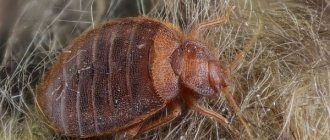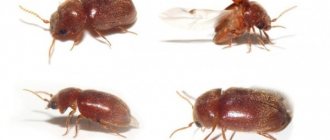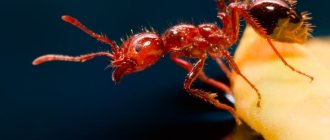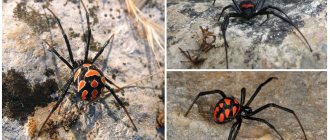What does it look like
The mole cricket or cabbage moth is a beetle with a body length of 5–8 cm, living mainly underground. He has a powerful shell. Under it, the insect from time to time partially hides its head, on which two large compound eyes are located.
When describing the cabbage weed, we always note strong front legs with claws, reminiscent of beetle claws. Thanks to them, the beetle creates a system of complex passages underground. It also has wings that allow it to fly over distances of up to five meters.
The beetle got its name “mole cricket” because of its brown color and powerful clawed front legs. They evoke associations with the famous furry predator.
Distribution and habitat
The habitat of the cabbage plant is wet places. It is usually found in floodplains of rivers and other bodies of water.
The common mole cricket lives throughout Europe except Norway. Its distribution range extends to western Asia. Residents of North Africa, Transcaucasia, Kazakhstan and Kyrgyzstan know firsthand about this insect. In the Russian Federation, it is found in regions located in the European part. The exception is some northern and northeastern regions.
Lifestyle and reproduction
Beetles spend most of their time in underground passages. They like to settle in areas with well-warmed soil, rich in humus, and in wetlands.
The beetle comes to the surface at night. Its presence can be recognized by loud trills at night.
Interesting! After rain, winding mounds with holes appear on the ground of the area where this insect has settled. They are noticeable where the beetle has made its passages, since the soil dries out faster above them.
Few people know that the mole cricket not only swims, but also flies well.
Insects (in the form of larvae) enter gardens with manure. They can also be seen in leaf humus, compost heaps, and sawdust.
The life cycle of the mole cricket begins when the soil layer to a depth of 30 cm warms up to a temperature of +15°C. In mid-May she builds a nest and lays eggs. In some regions this occurs closer to mid-June.
The female protects the clutch from predators and takes care of her eggs. To ensure that they warm up sufficiently, the cabbage weed destroys the vegetation above the laying site.
After 10–20 days, larvae emerge from the eggs. Outwardly, they are exactly the same as adults, only smaller in size. The larvae remain in the nest. The female feeds her offspring with plant leaves. After the first molt, the larvae leave the nest, and after overwintering, they become sexually mature. The development cycle takes 1.5–2 years.
Destruction of mole crickets in the garden
To effectively combat such a serious garden pest, you need to “know it by sight.” I’ll tell you about the life functions of the mole cricket:
- The insect is nocturnal. At this time of day, it gets out to the surface of the earth and changes its location.
- The mole cricket loves warm, moist soil, illuminated by the sun during the day. It prefers a substrate richly fertilized with manure, in which a “greenhouse effect” occurs.
- The insect is unusually prolific. Up to 500 larvae can hatch from one clutch of eggs. In terms of appetite, they can compete with locusts.
The first sign of a pest appearing in the garden is small areas that look like mown grass. The mole cricket cuts it off with its powerful jaws - it fights against shading, which interferes with the breeding of offspring.
signs of a mole cricket in the garden
Carefully monitor the pest operating in your garden - its burrows can be confused with manholes, passages of shrews and moles. But each of these uninvited guests has its own methods of struggle. Traps, bait, erection of natural barriers and the use of ultrasonic repellers are effective against mole crickets. They successfully fight pests using folk remedies.
If these methods are powerless, they turn to chemicals and biological poisons. If the use of such drugs is unsuccessful, “heavy artillery” is needed - a sanitary service specializing in large-scale pest control. Professionals work with powerful chemicals that literally destroy all life on the site. Therefore, turning to such a drastic remedy is justified only in case of a large invasion of earthen crayfish.
What do they eat?
The insect feeds on almost all agricultural crops. His diet also includes food of animal origin.
Tubers
One of the favorite “dishes” of kapustyanka is potato tubers. The insect bites into them, making them unfit for consumption.
Root neck
If cabbage weed damages the root system of plants, for example potatoes, then the leaves quickly wither and the stems fall to the ground. If you notice wilted bushes in an area where there is no lack of moisture, check to see if this beetle has settled there.
Note! The larvae cause no less damage to the root collar of garden plants than adult mole crickets.
They do not have as powerful jaws as their parents. Their diet mainly includes root collars and seeds, which are easy to bite through.
Young shoots and seeds
The beetle loves to feed on young shoots. For this reason, the garden must be protected from mole crickets from early spring until the end of the harvest.
Types of mole crickets
There are several different species that practically do not differ from each other: they have the same lifestyle, taste preferences and appearance. The difference can only be noticed if you examine their chromosome set. There are about 110 species in total, among the known ones are the following: Common - one of the largest groups that is widespread in Europe.
Damages all types of grains and agricultural crops. African - grows up to 3.5 cm, body color is dark yellow, closer to brown. The abdomen is light yellow. It has small thread-like antennae. Ten-fingered - the species is widely represented in the USA and Canada. The size is from 2 to 3.5 cm. In its natural habitat it has an enemy - the ground wasp, it penetrates the mink and paralyzes with its sting.
The Far Eastern mole cricket is morphologically close to the common mole cricket and is distributed in China, Vietnam, Japan and the Sakhalin region. Single-spike - differs from other species in that the thickness of its body is narrower, and the front wings have not very pronounced transverse veins. The length of a mature individual reaches 4.5 cm. And the steppe mole cricket, which lives in the south of Russia, Ukraine and a number of other countries, is also quite famous.
Favorite plants
It is difficult to name crops that the mole cricket does not like. She loves to chew on everything that gets in her way. A list of the most popular can be seen below.
New potatoes
The mole cricket loves young potatoes, as their tubers contain a lot of moisture. They are easier to chew and appear in gardens quite early, when there is no other crop yet.
Fodder and sugar beets
This vegetable also attracts cabbageweed. The insect loves sugar. There is a lot of it in fodder and sugar beets, so it eats these vegetables with pleasure.
Carrot
Sweet carrots can also be damaged by mole crickets. At the same time, the tops remain untouched and it is difficult to guess the problem from the outside. However, the carrots themselves are half eaten from the inside or up to the tops.
White cabbage
This vegetable suffers from the invasion of cabbage grass, as it damages its root system. This insect is especially dangerous for seedlings, which can be completely destroyed.
Tomatoes and eggplants
Cabbage grass is also dangerous for nightshade plantings. Having multiplied in the area, the beetle can destroy tomatoes. He feasts not only on the root system, but also on the fruits that are on the ground. Eggplants also fall prey to this insect.
bell pepper
A mole cricket can even live in a greenhouse. The underground part of the bell pepper suffers from its activity. As a result, the plant will wither and die.
Pumpkin
Mole cricket can cause serious damage to plants belonging to this family, such as pumpkin, watermelon, melon, and cucumber. It gnaws through their root system and stems.
Strawberries
Sweet strawberries attract cabbage grass. This beetle also harms the underground part of the plant.
Methods of pest control
Now that we know what a mole cricket looks like and how dangerous it is, we can consider real tips on how to remove a mole cricket from your land using folk remedies.
- In areas occupied by the enemy, it is recommended to plant marigolds and marigolds everywhere. Plant in flowerbeds, between seedling bushes, between rows of trees, etc. The more marigolds and calendula (marigolds), the better - the mole cricket cannot stand the smell of these plants!
- When feeding any plants in the garden with organic fertilizers, reduce the dose of manure applied as much as possible, and try to avoid it altogether. Replace manure with chicken droppings, whose smell repels mole crickets. If you need powerful fertilizing of the soil before winter, plant lupine. Buried under the snow even before the formation of beans, this simple flower is in no way inferior to manure in terms of the quality of soil fertilization, moreover, it will improve its health and drive out harmful insects. The mole cricket also does not like the smell of garlic and coriander (cilantro).
- Feed the hungry insect in the spring with “grass” consisting of a mixture of oats, bran and peas, generously flavored with unrefined oil and karbofos. The mole cricket will definitely find a “delicacy” buried at a shallow depth and die.
- If the beer has fermented, take it to the garden beds! The fermented intoxicating drink must be poured into enemy holes, and the enemy will quickly capitulate. There are also beer traps for mole crickets, but catching them with beer alone is a weak hope.
- A good option is to spill the beds with soapy water after washing with laundry soap. If you add ammonia to this cooled solution, the effect will be impressive.
- You can protect greenhouses and site boundaries from invasion by building small ditches and filling them with sand or shavings with the smell of kerosene. By the way, this method was also used by Michurin.
- But still, the best results in the fight against harmful insects are obtained from mole cricket chemicals, sold in hardware stores. Granular preparations are easy to use, it is difficult to overdo it, and they are more effective than all folk remedies taken together.
https://youtube.com/watch?v=E9FP6d1nCAU
https://youtube.com/watch?v=E9FP6d1nCAU
But if the struggle during the season is unsuccessful, there is another chance to destroy the pest. After harvesting the remains of the crop, dig small holes 40-50 cm deep, line their bottom with cellophane film, fill them with manure (preferably horse manure) and wait until a record number of mole crickets gather there to spend the winter, and then simply throw away the film with the “filling” in the cold. Nature will take care of eliminating pests.
Cereals
The mole cricket eats grains with pleasure. To combat it, it is recommended to use boiled wheat, mixing it with some insecticide at the rate of 2-3% by weight of the dry product.
The insect also feeds:
- oats;
- barley;
- rye;
The kapestyanka also likes corn. The beetle poses a danger to its seedlings. It is also known that in the absence of cereals, its fertility decreases.
Exceptions
Although the mole cricket is practically omnivorous, it does not like some agricultural crops. Which ones exactly? More on this below.
Beans
It is noticed that the insect does not touch the beans. Some gardeners even plant this plant around the perimeter of the plot and claim that after this the cabbage plant does not appear there.
Parsley
The insect feeds on the roots of this plant. However, it is believed that the smell of parsley repels him.
Onion and garlic
The husk of this vegetable, or rather its smell, has a deterrent effect on the mole cricket. In the beds where onions grow, the brown beetle is almost never found.
Garlic repels mole crickets more effectively than any other plant. By planting it on your site, you can be sure that the insect will avoid it.
Measures to combat garden pests
Using special drugs
The use of chemicals that have a positive effect in the fight against mole crickets in the garden involves direct contact of a toxic substance with the insect or its absorption of poisoned bait.
The preparations are introduced into the soil layer to a depth of 10 cm, thoroughly loosening and mixing the soil with a rake. You can fight to free your summer cottage from harmful insects using one of the following poisons - baits (per sq. m.):
- Medvetox – 3 g;
- Grizzly – 2 g;
- Phenaxin plus – 10 g;
- Thunder – 3 gr.
Chemical methods of combating mole crickets also include self-prepared baits with the addition of insecticides:
Recipe for grain bait based on Bankol or karbofos
Boil 1 kg of grain, cool until warm and add:
1st option:
- Sunflower oil – 50 g;
- Bankol – 10 gr.
2nd option:
- Sunflower oil – 30 g;
- Karbofos – 50 gr.
Freshly prepared bait is placed in the tunnels made by the underground pest and must be sprinkled with soil to prevent poisoning of the birds. Application rate – 10-20 pcs. grains per hole-hole. You should not use poisonous baits in the garden area where green crops are planted - onions, lettuces, dill, parsley.
Bait recipe using split peas
We dilute an ampoule of any available insecticide (Decis, Inta-Vir, Atkara, Antizhuk, etc.) in a liter of water, and soak split peas in the resulting solution and mix thoroughly. The bait is ready when the grain has absorbed all the liquid.
Using pea halves prevents their germination. The bait is embedded in the beds during digging or placed in all discovered passages and holes.
Bait with stale bread
Soak bread crumbs broken into pieces for several minutes in 1 liter of water, to which we first add the contents of 1 ampoule of insecticide and 1 tbsp. a spoonful of vegetable oil. Place croutons in the holes when planting potatoes and tomato seedlings and sprinkle with soil.
How to fight mole crickets using traps
For those who do not want to use industrial insecticides in their garden, traps will help in the fight against harmful insects.
Bottles with liquid baits
It has been noted that these harmful insects are attracted to the smell of sour beer or kvass. Diluted honey and molasses also give a positive result. About 1/2 cup of liquid is poured into bottles and buried up to the neck overnight in the garden.
The mole crickets caught in the container must be destroyed the next day, because... pests can get out of the bottle and run away. It has been noticed that individual individuals can swim in liquid for up to 3 days, and then fly away.
Holes with potato bait
To combat the gnawing of seed, holes called traps are created in the potato plot. A few days before planting the tubers, holes are made in the prepared area over the entire area, 1 spade deep.
Place potato peelings or raw potatoes cut into pieces at the bottom. Cover the top with rotten grass, old leaf litter or manure. The holes are inspected 2-3 times, and the caught individuals are destroyed.
Autumn traps with fresh manure
You can effectively fight mole crickets in your summer cottage in the fall. It is known that the insect begins to settle down for the winter when the temperature drops below 8 degrees. Without waiting for the weather to get colder, trapping pits are prepared. Holes 40–45 cm deep are lined with film and filled with fresh manure.
Mole crickets willingly take advantage of the warm shelter provided and climb into the trap in large numbers. After waiting for frost, the filling of the pit is removed and scattered. All pests freeze and die. On 1 acre of garden, at least 4 traps are made.
A method proven by many summer gardeners, which allows you to collect and destroy up to 500 individuals per season, is the use of soap and soap-oil solutions. There is no clear opinion about which solution fights insects better. Application practice shows great success of one or the other composition.
What animals are consumed?
The mole cricket feeds not only on plant foods. As soon as it emerges from the eggs, it consumes the larvae of beetles and click beetles. Having transformed into an adult, the beetle eats some other insects.
Earthworms
Earthworms often become prey for mole crickets. They meet on his way in the process of digging underground passages and are mercilessly eaten, becoming a source of animal protein.
Colorado beetle
The Colorado potato beetle is a well-known pest that destroys potatoes. His meeting with a mole cricket usually has dire consequences. The more powerful cabbage plant destroys the Colorado potato beetle, but it itself causes no less damage to potatoes.
Ladybug
The ladybug is also one of the victims of the mole cricket. True, the beetle does not feed on the ladybugs themselves, since they can fly and are difficult to catch, but on their larvae living in the ground.











